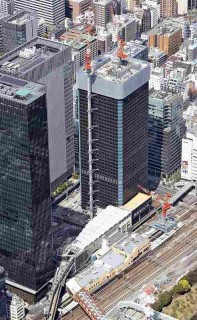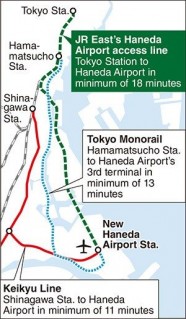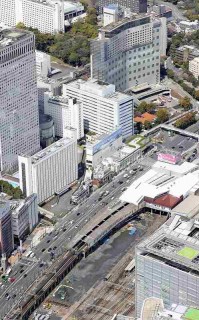Loading
Search
▼ Railways Improving Hubs Linked To Haneda Airport
- Category:Other
Tokyo Monorail and its rival Keikyu Line, both of which travel directly between Haneda Airport and central Tokyo, are redeveloping the areas around their hub stations in a bid to attract more passengers.
East Japan Railway Co. will open a new line stretching between Haneda Airport and Tokyo Station in fiscal 2029, and the advent of this new competitor has spurred Tokyo Monorail Co. and Keikyu Corp. to improve the convenience of their stations and the appeal of the surrounding areas.
Long-standing rivals
Tokyo Monorail started operations in 1964, when Tokyo first hosted the Olympic Games, and initially monopolized transport services to and from Haneda Airport.
However, the situation changed drastically in 1998, when Keikyu also started providing access.
This led to fierce competition between the two companies to attract more passengers.
According to the Land, Infrastructure, Transport and Tourism Ministry, 70% of airport passengers used the monorail system before Keikyu extended its line to Haneda.
Keikyu shortened the time required to get to and from Haneda and increased the number of direct trains, causing the percentage of passengers using the Keikyu Line to surpass that of the monorail from fiscal 2015 on.
The fight for passengers is expected to become even more intense in the future, with a three-way competition shaping up.
JR East plans to open the tentatively named Haneda Airport access line in fiscal 2029, which is expected to directly connect Tokyo Station and Haneda Airport in 18 minutes at the fastest.
Passengers rushing to Haneda Airport after changing at Tokyo Station from the Tohoku, Joetsu, and Hokuriku Shinkansen lines will find the new service convenient.
Both Tokyo Monorail and Keikyu are nearing the limit of their ability to shorten travel time to and from the airport.
It is also difficult to lower fares, as passengers have decreased due to the outbreak of the novel coronavirus, prompting them to improve the convenience of their hub stations.
Hamamatsucho Station
Hamamatsucho Station is the first station on the monorail line and has been in operation ever since the line debuted.
Passengers were often confused, however, by ticket gates being located on both the second and third floors.
The station building has been under reconstruction since last November as part of the redevelopment of the area around the station.
This includes the adjacent World Trade Center Building, which is being demolished.
The ticket gates will be merged on the third floor, so that passengers can transfer to JR and subway lines, and to long-distance buses, simply by taking an escalator down from the platform.
The station building is slated for completion in December 2029. By that time, four 150- to 200-meter-tall buildings will stand at the west exit of Hamamatsucho Station, creating a new landmark for Tokyo.
The new World Trade Center Building is expected to include facilities that introduce various regions of Japan to foreign visitors through video and other means.
An international conference center will also be located in the new World Trade Center Building and is expected to attract tourists and business travelers from overseas.
Tokyo Monorail intends to enhance the links between the station building and the World Trade Center Building to attract more airport users.
“We want to promote the station as a hub for business, tourism and transportation,” an official of the firm said.
Shinagawa Station
In April last year, Keikyu embarked on a project to improve its key hub of Shinagawa Station.
In addition to adding a platform to increase its capacity, the firm plans to move platforms from the second floor of the station building to the first, to make it easier for passengers to transfer smoothly from JR lines.
Construction is scheduled to be completed in 2027, the same year that the Linear Chuo Shinkansen service to and from Shinagawa Station is scheduled to begin service.
Together with the Tokaido Shinkansen, the maglev train will enhance Shinagawa Station’s status as the southern gateway to Tokyo.
Keikyu is demolishing a 30-story building complex at the west exit of Shinagawa Station.
The 25,000-square-meter site will be used to create a new building complex with a hotel, offices and commercial facilities. It is expected to open when the renovation of Shinagawa Station is completed.
“Convenience will be further enhanced. After the pandemic is over, we want to focus on attracting overseas customers as well,” a Keikyu official said.
“There’s a limit to the speed and fare competition for both the monorail and Keikyu, and it’s natural for them to pursue comfort in and around stations,” said Takayuki Kishii, visiting professor of urban transportation planning at the National Graduate Institute for Policy Studies.
“Instead of competing with each other for passengers, it will become more important for them to improve their own features. The monorail should focus on its role as a transportation service for residents along the rail line, and Keikyu should take advantage of Shinagawa Station’s connections with the maglev and the Tokaido Shinkansen trains,” Kishii said.
- April 19, 2022
- Comment (0)
- Trackback(0)




